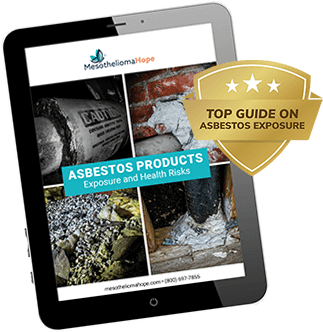What Are Asbestos-Related Pleural Diseases?
Pleural diseases are health problems that start in the pleura.
Anyone exposed to asbestos in the workplace or at home is at risk of breathing in or swallowing microscopic asbestos fibers. When these fibers get trapped in the pleura, they can lead to inflammation and scarring.
Over time, the harmful effects of asbestos can trigger benign (non-cancerous) and/or malignant (cancerous) pleural diseases.
Asbestos-related pleural diseases include:
- Mesothelioma (cancer in lung lining)
- Pleural effusion (fluid buildup in lung lining)
- Pleural plaques (buildups of protein in lung lining)
- Pleural thickening (scarred lung lining)
Asbestos pleural diseases have a long latency period, taking 10-50 years to develop after asbestos exposure. However, some of these diseases — particularly pleural mesothelioma cancer — are serious and even deadly.
If you or a loved one has a pleural disease or illness, download our Free Asbestos Products Guide to learn how you may have been exposed to this dangerous mineral and what you can do next.
Types of Asbestos-Related Pleural Diseases
There are several types of asbestos pleural diseases. Each type has its own symptoms, prognosis (health outcome), and treatment options. Learn about the different diseases below.
Pleural Mesothelioma
Malignant pleural mesothelioma is an aggressive cancer that develops in the pleura. The only known cause of pleural mesothelioma is asbestos exposure.
Pleural mesothelioma causes symptoms such as chest pain, chronic coughing, and shortness of breath. Symptoms get worse as the cancer spreads.
Pleural mesothelioma patients have an average life expectancy of 18 months, but an early diagnosis and treatment can help some patients become long-term survivors.
Mesothelioma Hope can help you find top doctors, treatments, and compensation for pleural mesothelioma. Call (866) 608-8933 now to get started.
Diffuse Pleural Thickening
Diffuse (widespread) pleural thickening occurs when the pleura hardens due to scarring (pleural fibrosis). The scarring and thickening develop because asbestos fibers constantly irritate the pleura after exposure.
Pleural Effusions
An asbestos pleural effusion is a buildup of fluid between the two layers of the lung lining (the pleural space). Pleural effusions cause pain and swelling.
Doctors can drain the fluid to ease symptoms. If the pleural effusion is caused by another pleural disease such as mesothelioma, it may build up again, so doctors might need to drain it more than once.
Pleural Plaques
Pleural plaques are the most common asbestos-related disease. They are small clumps of a protein called collagen that form in the lining of the lungs. These lesions form as part of the body’s reaction to asbestos exposure.
Unlike other asbestos-related pleural diseases, pleural plaques don’t cause symptoms and are harmless. Those with pleural plaques from asbestos can live just as long as those without.
However, people with asbestos-induced pleural plaques could be at risk of mesothelioma and other asbestos pleural diseases due to their exposure.
Download our Free Asbestos Products Guide to learn how you could have been exposed to asbestos and how to get help if you’re now sick.
Risk Factors for Asbestos-Related Pleural Disease
The number one risk factor for asbestos-related pleural diseases is exposure to asbestos. Anyone exposed to asbestos could develop a pleural disease later in their life. Still, the risks are greater for some groups of people than others.
Those at a very high risk of asbestos pleural diseases include:
- Blue-collar workers: Before the early 1980s, blue-collar jobs like construction and shipyard work relied on asbestos (as the risks of asbestos were hidden by companies). Many workers who suffered occupational exposure to asbestos now have pleural diseases.
- People in poor health: Those with pre-existing health problems could be at a higher risk of an asbestos-related pleural disease.
- U.S. veterans: The U.S. Armed Forces used tons of asbestos products prior to the early 1980s. Since asbestos-related pleural diseases take decades to develop, many veterans exposed to asbestos during their military service are just now being diagnosed.
Symptoms of Asbestos Pleural Diseases
Asbestos pleural diseases have similar symptoms, such as:
- Breathlessness (dyspnea)
- Chest pain
- Chronic coughing
- Difficulty breathing
- Fever
- Night sweats
- Shortness of breath
- Weight loss
Signs and symptoms of asbestos pleural diseases typically develop 10 to 50 years after asbestos exposure. Symptoms can vary depending on which asbestos-related pleural disease a patient has.
Contact us to get help if you or a loved one has symptoms of an asbestos pleural disease. We can help you get financial aid if you qualify.
Diagnosing Pleural Diseases Caused by Asbestos
To find out if you have an asbestos-related pleural disease, your health care provider will perform several tests to properly diagnose you.
Tests to diagnose pleural illnesses include:
- A basic medical exam to see what symptoms you have and when they started.
- Chest X-rays (radiography scans) that use low doses of radiation to create pictures of the inside of your chest cavity.
- Computed tomography scans (CT scans), which are computer-guided imaging scans that are more detailed than X-rays. Radiology professionals can use high-resolution CT (HRCT) scans to look for chest abnormalities.
- Other tests like blood tests, ultrasounds, and pulmonary lung function tests. Which tests are done depends on the nature of your case.
If doctors believe you have mesothelioma or any other type of cancer after running these tests, they will order a biopsy.
A biopsy is a procedure to remove a sample of cells from your body so it can be tested in a lab for cancer and other diseases. A biopsy is the only way to confirm a cancer diagnosis.
Prognosis of Asbestos Pleural Diseases
Your prognosis depends on which asbestos-related disease you have.
Many asbestos-related pleural diseases don’t affect your life expectancy For example, asbestos pleural effusions are uncomfortable but not fatal.
Pleural mesothelioma has the worst prognosis of all asbestos-related pleural diseases since it’s a very aggressive cancer. But don’t give up hope: long-term survival is possible with treatment from a mesothelioma doctor.
Treatment for Asbestos Pleural Diseases
Treatments for asbestos-related pleural diseases can ease your symptoms and possibly help you live longer.
Which treatments will work best in your case depends on the disease you have. Learn about common treatments used for asbestos pleural diseases below.
Chemotherapy
Chemotherapy drugs kill fast-growing cancerous cells. Doctors usually use two chemotherapy drugs to treat pleural mesothelioma: pemetrexed and cisplatin.
Pleural Catheter
If you have repeated pleural effusions, health care professionals may insert a pleural catheter. This will allow you and your caregivers to drain the effusion at home without the need for multiple hospital visits.
Pleurodesis
This is used to treat pleural effusions that keep coming back despite other treatments. Through a pleurodesis, doctors insert medical talcum powder into the pleural space. This causes the two layers of the pleura to stick together, preventing fluid buildup.
Radiation Therapy
Radiation therapy involves using high-energy X-rays to kill cancer cells. Cancer doctors may use radiation therapy to treat pleural mesothelioma.
Surgery
Doctors can use several surgical procedures to treat asbestos-related pleural diseases.
Common surgeries for asbestos pleural diseases include:
- Extrapleural pneumonectomy (EPP) removes the lung nearest to the cancer, the pleura, and all cancer tumors that doctors can see.
- Pleurectomy with decortication (P/D) allows doctors to remove the pleura and cancer tumors from the chest wall. Neither lung is removed.
- Thoracentesis uses a needle to remove air or fluid around the lungs.
- Thoracostomy is a procedure for placing a chest tube. The chest tube drains air or fluid out of the pleural space. Doctors can use thoracostomy to treat pleural effusions and pneumothorax.
Mesothelioma Hope can help you get compensation to cover the costs of surgeries and other treatments for asbestos-related pleural diseases. Contact us now to learn more.
Other Pleural Disease Treatment Options
Medical providers may recommend other treatments depending on your needs.
These options include:
- Immunotherapy uses substances made in a lab or by your body. These substances make it easier for your immune system to identify and kill mesothelioma cells.
- Palliative care helps relieve pain for various asbestos-related pleural diseases. Medications, minor surgeries, and natural remedies are all considered palliative treatments.
- Targeted therapy uses drugs that attack certain vulnerabilities in mesothelioma cells.
- TTFields are mild electrical fields that interrupt pleural mesothelioma cells’ ability to divide.
Depending on your illness, doctors may also recommend new treatments being tested in clinical trials. Talk to your doctor to learn more about clinical trials and whether they can help you.
Compensation for Asbestos-Related Pleural Diseases
Treatments for asbestos pleural diseases are often expensive — even with insurance. Thankfully, Mesothelioma Hope can help you access financial aid from different sources if you’re eligible.
Here are the main types of compensation for asbestos pleural diseases.
Asbestos Lawsuits
An asbestos lawsuit is used to demand compensation from the companies that made and sold asbestos-containing products. These companies knew the dangers of asbestos but hid them for decades.
Victims receive $1 million or more on average from asbestos lawsuits.
Asbestos Trust Fund Claims
Asbestos trust funds were set up by manufacturers of asbestos-containing products that went bankrupt. It’s not possible to sue a bankrupt company, but victims can still get compensation by filing a trust fund claim.
Over $30 billion is currently available in asbestos trust funds. Patients with mesothelioma and other asbestos-related pleural diseases may be able to access some of this compensation.
We can help you file trust fund claims to get compensation for asbestos-related pleural diseases. Find out your eligibility right now.
VA Claims
The U.S. Department of Veterans Affairs (VA) offers benefits for certain asbestos-related diseases, such as pleural mesothelioma.
Veterans with mesothelioma can often receive nearly $4,000 a month from VA benefits as well as free or reduced-cost medical care from VA doctors.
Get Help for Asbestos-Related Pleural Diseases
Mesothelioma Hope is here to help if you or a loved one is battling an asbestos pleural disease.
Our caring nurses and Patient Advocates can connect you with emotional and financial support resources and help you pursue compensation for treatment if you qualify.
Remember, you could receive $1 million or more if you’re eligible to file an asbestos lawsuit.
Call (866) 608-8933 now to speak directly with a Patient Advocate who can help.
Asbestos-Related Pleural Diseases FAQs
What are the three lung diseases caused by asbestos?
The three most notable lung or lung-related diseases caused by asbestos are mesothelioma, lung cancer, and asbestosis.
- Mesothelioma cancer develops in the lining of the lungs and other organs, affects 3,000 people each year, and is very difficult to treat.
- Asbestos-related lung cancer can develop if asbestos fibers get stuck in the lungs. Thousands die from asbestos lung cancer each year, according to the Environmental Working Group.
- Asbestosis is a benign (non-cancerous) asbestos-related illness where the lung tissues slowly stiffen due to damage from asbestos fibers.
Mesothelioma Hope may be able to help you get medical care and/or financial aid for your illness. Contact us today to learn more.
What is asbestos-related pleural fibrosis?
Pleural fibrosis occurs when the lining of the lungs thickens and hardens due to asbestos exposure.
Asbestos fibers can get trapped in the lung lining and cause damage, which in turn leads to fibrosis. Pleural fibrosis is also known as diffuse pleural thickening.
What is the difference between asbestosis and pleural plaques?
Asbestosis and pleural plaques are two entirely different asbestos-related diseases.
Asbestosis affects the lungs, slowly weakening them to the point where patients may eventually die. Pleural plaques form in the lung lining and don’t cause any symptoms or health problems.
If you’re worried you may have an asbestos-related disease, see a doctor right away to get diagnosed and treated.
What is the life expectancy of asbestos patients (in the lungs)?
It depends on which asbestos-related pleural disease you have.
Nonmalignant pleural diseases such as pleural plaques usually don’t affect your lifespan.
However, severe pleural diseases may reduce your life expectancy. For example, pleural mesothelioma patients survive 18 months on average, but you can increase your life expectancy by getting a proper diagnosis, treatment, and follow-up care.




